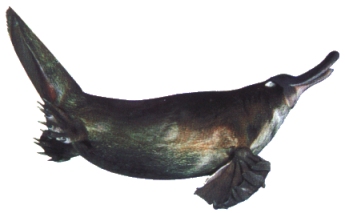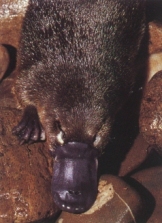PLATYPUS

The platypus is a monotreme, an animal with one hole. It has one vent, called the cloaca, through which digestive wastes, urine, eggs and sperm all leave its body. This remarkable mammal lives near unpolluted waterways in Eastern Australia, from Cooktown south to Tasmania. It spends much of its time in the water and its eyes are set on top of its head, while its nostrils open on top of the leathery bill. The fine, dense fur is waterproof.
A Platypus hunts underwater for small aquatic animals such as insect larvae, shrimps and worms. These are stored in cheek pouches, and then taken to the surface, where they are chewed between horny grinding plates and ridges on the Platypus's upper and lower jaws, then swallowed. (A baby Platypus has teeth but loses them about the time that it is weaned.) A modern discovery about the Platypus is the fact that it swims with its eyes, ears and nostril shut. It locates the small water animals on which it feeds by detecting electric signals from their bodies with special sensors on its wide, flat bill.
The Platypus propels itself with its forefeet, using its hind feet as brakes and for steering. It may stay submerged for up to one minute. The broad, flat tail of the Platypus is used to store body fat. The spurs of the male Platypus are probably used in territorial fights in the springtime breeding season.
Mating takes place in the water. The female digs a breeding burrow that may be up to 20 metres in length. She lays 2 soft, sticky eggs, each about 17 millimetres long, then incubates them between her abdomen and tail for about 2 weeks. The young suck milk that oozes onto patches on her abdomen. They leave the burrow after 3 months and are weaned between 4 and 5 months.

DID YOU KNOW?
- A small female Platypus weighs 700g. A big male weighs 3 times as much!
- A small female Platypus measures 40cm from bill tip to tail tip, while a big male measures 55cm.
- When digging or walking, the Platypus turns back the webs on its front feet to reveal broad nails.
- In cold water, a Platypus can increase its body's heat-production to keep its temperature around 32ºC.
- A platypus has no nipples.
- A Platypus may hibernate in its burrow during cold southern winters.
- An opalised platypus jaw found at Lightning Ridge has been dated back to around 120 million years ago!
- Monotremes have a normal body temperature of 30ºC. Marsupials average 35ºC, while human body temperature is normally 37ºC.
| BACK TO MAMMALS |
| mammals | | | birds | | | reptiles | | | spiders |